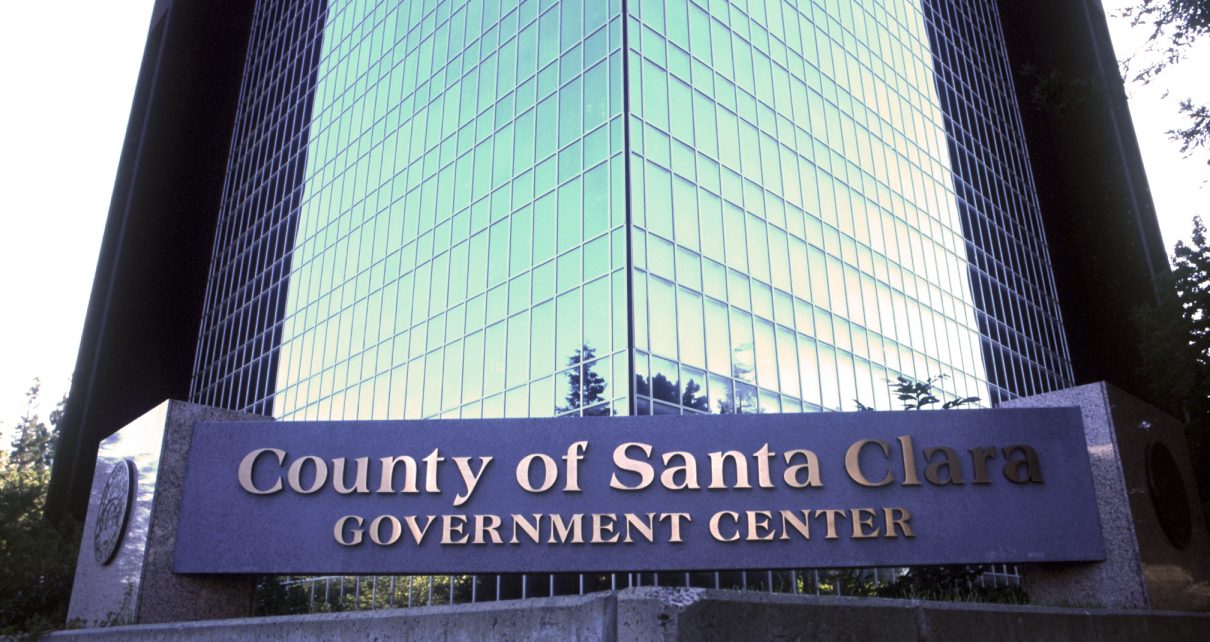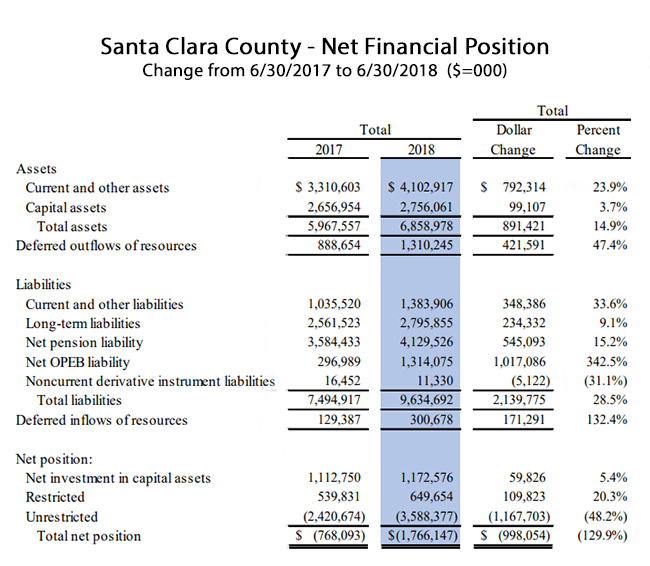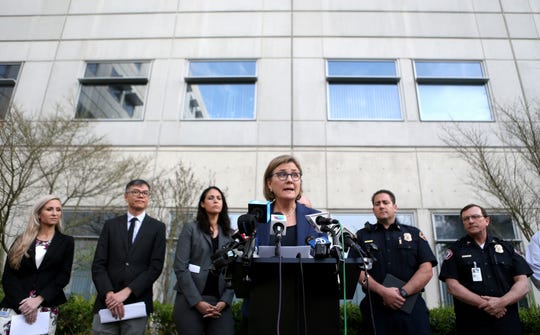
Santa Clara County Government Center. (sccgov.org)
Public Employee Strike Looms in Santa Clara County
Sooner or later, liabilities sitting on a balance sheet have to be paid
By Edward Ring, January 3, 2020 6:35 am
With 2020 upon us, it appears likely that two unions representing Santa Clara County employees will be going on strike. Unless agreements can be reached, 3,000 members of the Registered Nurses Professional Association will strike, along with over 11,000 members of the SEIU.
When one considers the political leanings of the Santa Clara County Board of Supervisors, which tilt overwhelmingly pro-labor in one of the most liberal strongholds in the world, it seems inexplicable that negotiations have reached an impasse. Inexplicable, that is, until you review the financial situation confronting Santa Clara County.
To get started, have a look at the most recent publicly available consolidated balance sheet for Santa Clara County, showing the change in their assets and liabilities between their fiscal years ending 6/30/2017 and 6/30/2018.

As can be seen from this table (found on page 7 of Santa Clara County’s most recent CAFR), the county’s total assets increased by an impressive $891 million between 2017 and 2018. But the county’s total liabilities increased by an even more impressive $2.1 billion over the same period, nearly three times as much.
Digging in, it isn’t hard to see what happened. Santa Clara County’s finance department finally decided to accurately represent the size of their unfunded retirement obligations. They increased their net pension liability by $545 million, and they increased their OPEB (“other post employment benefits,” typically retirement health insurance coverage) liability by $1.0 billion.
Anyone who has dug around financials long enough knows that the balance sheet is where the bones are buried. Simply expressed, sooner or later, liabilities sitting on a balance sheet have to be paid. And in the case of Santa Clara County and other agencies up and down the state, it’s turning into sooner rather than later.
The reason for this is because CalPERS, adhering to long overdue new requirements from GASB (the government accounting standards board), has decided to require their participating agencies to pay down their unfunded pension liability within twenty years. Previously, as this liability crept relentlessly skyward, creative accounting allowed payments to be deferred. The result can best be described as analogous to those negative amortization mortgages that were popular right up until the real estate bubble blew up in 2009.
To see what all this means in terms of actual county expenditures, refer to the official “Public Agency Actuarial Valuation Reports” provided by CalPERS for Santa Clara County. These reports disclose how much CalPERS is going to require Santa Clara County to pay them over the next several years.
How Much is Santa Clara County Going to Pay CalPERS?
According to a recent CPC analysis which consolidates the CalPERS projections for all major employee groups (download here), during the current 2019-20 fiscal year, CalPERS is demanding $652 million from Santa Clara County. Of that $652 million, Santa Clara County employees, via payroll withholding, will contribute $145 million, or 22 percent. Put another way, for every five dollars that taxpayers send to CalPERS this year to fund Santa Clara County employee retirement pensions, those employees themselves will kick in just over one dollar.
It gets worse. By the 2025-26 fiscal year, CalPERS will require Santa Clara County to pay $904 million to keep their pensions afloat. And of that total contribution, county employees will themselves be required via payroll withholding to contribute $170 million, or 19 percent. The employer share will increase by $227 million, or 45 percent. By 2025, for every five dollars that taxpayers send to CalPERS to fund Santa Clara County employee retirement pensions, those employees themselves will kick in less than one dollar.
Santa Clara County’s board of supervisors is staring down an increase to their annual CalPERS payment that in a few short years will be nearly a quarter-billion dollars higher than it is today. And based on the recent billion dollar bump to the county’s OPEB liability, Santa Clara County payments to fund retiree health care are also set to dramatically increase. This is the implacable financial reality that is behind their tough negotiations with the unions.
How Much Are Santa Clara County Pensions?
The website Transparent California has a helpful summary search page “View pensions by last employer.” On this page, by selecting “View all CalPERS employers,” it is possible to view “average pension and benefit amount for full career retirees” for each employer. As can be seen, Santa Clara County employees who have worked for 30 years currently collect an average annual pension of $84,349, not including benefits such as employer subsidized retirement health insurance.
This is an astonishing sum, considering the maximum Social Security benefit – only paid for high wage earners once they’ve reached the age of 70 – is $45,480. For a 62 year old, which is a far more representative comparison, the maximum Social Security benefit is $27,180, less than one-third what the average Santa Clara County employee receives.
It is important to emphasize that using full-career pension averages is the only valid means of comparison to private sector retirement benefits. It is common to read statements from public sector union officials claiming the “average pension” is only $30,000 per year, or less. But they are including in these averages those recipients who only worked a few years, and barely vested their pensions. This is an inaccurate basis for comparison, because people who have only worked a few years in the public sector would presumably have spent their other working years in the private sector, earning social security and saving what they can in a 401K plan like the rest of us.
It is easy enough to review the actual individual pension data for Santa Clara County’s retirees. Here’s the link to Transparent California’s 2018 data. For each individual, it shows the amount of their pension, the year they retired, and their total years of service. Most people who view this data for the first time are amazed.
How Much Do Santa Clara County Employees Make?
Answering this requires understanding a few layers of assumptions. The most detailed primary source of data is the PublicPay.gov website managed by the California State Controller. On that website, Santa Clara County employees are shown for 2018 to average $92,069 in regular pay (plus overtime and other pay), along with $23,348 in employer payments for current and future benefits. That would mean that according to the State Controller, the average total compensation for a Santa Clara County employee was $115,417 in 2018.
This, however, is the low number, for two very significant reasons. First, as the state controller states, “employees who work partial year and/or part-time are counted as full time employees in the averages calculations.” This makes a big difference, as does the state controller’s other disclosure, “this county does not include payments toward the unfunded liability of the employer sponsored retirement plan.”
To get at Santa Clara County’s average for full-time employees with benefits, the raw data is available from the state controller on their “downloads” page. The 8.4 MB “2018 County Data” file includes detailed records for 22,159 Santa Clara County employees. In the CPC analysis that can be downloaded here, records for part-time employees were not included in the average. To do this, the records were screened to eliminate employees who were not collecting benefits, made less than $30,000 in base salary, or made less than the minimum specified base salary for their position.
These results are startlingly different from what the state controller reports. Instead of total pay averaging $92,069, and total benefits averaging $23,348, when screening out part-time and temporary workers, Santa Clara County employees average $118,220 in total pay, and $32,285 in total benefits. That’s an average total compensation of $150,505. But there’s more. What about the “payments toward the unfunded liability”?
Understanding this last element of total compensation underscores the inadequacy of pension reform to-date. Because of the $652 million that CalPERS will collect from Santa Clara County this year, $298 million will be to pay down the unfunded liability. That comes down to another $17,000 per each of Santa Clara County’s full-time-equivalent employees, an amount that’s rising every year. Of the $904 million coming due in 2025, $473 million will be to pay down the unfunded liability. Pension reform negotiations have never included any role for public employees themselves to pay down the unfunded liability, despite the fact that the benefits they receive depend on it being paid down.
Much more should be said about how CalPERS was, and is, understating the normal contribution in order to shield public sector workers from the true cost of their pensions. For a focused discussion on this topic, read “How Fraudulently Low ‘Normal Contributions’ Wreak Havoc on Civic Finances.”
If anyone is still reading this, there is yet another eye-glazing but nonetheless significant factor, the cost of OPEB (primarily retirement health insurance). For Santa Clara County’s public employees, this is an unfunded liability that is even bigger than the one for pensions. And this, too, must be prefunded and assessed as part of total compensation, if one is to accurately report on how much Santa Clara County employees are really making in pay and benefits.
To summarize, when taking into account the true cost of responsibly prefunding all of their retirement benefits, the average total compensation for Santa Clara County’s public employees, today, is already easily in excess of $170,000 per year.
What Are Reasonable Solutions to Santa Clara County’s Employee Disputes?
Jennifer Celaya, a Santa Clara County employee, wrote in support of a strike earlier this year in a guest column in the San Jose Spotlight. Here’s what she had to say about pensions: “One of the biggest public concerns is public employee pensions. Nevertheless, public employees are not the ones who lost hundreds of millions of dollars by making highly risky investments with public pension funds. The culprit is CalPERS, not the workers. An honest evaluation of CalPERS’ performance demonstrates poor judgement and insufficient returns. Some of those investment decisions have over the years led to serious loses, such as their ENRON and PG&E investments.”
Celaya is right. It is CalPERS fault. But the blame goes back further than their investment decisions of the past few years. It goes all the way back to Senate Bill 400, enacted in 1999, which increased pension benefit formulas by roughly 50 percent for California Highway Patrol officers. Over the next five years or so, nearly every state agency, city, and county in California followed suit, not only for their police and firefighters, but for all public employees regardless of their job description. The ongoing financial impact of this on civic budgets has been severe, and there is no end in sight.
One can easily make the case that CalPERS failed to disclose the costs of this historic bump in pension benefit formulas. But then again, before blaming CalPERS exclusively, it might be fair to take a look at who controls CalPERS. Of the 12 active CalPERS board members, only two of them have significant private sector experience. Most of them have spent their entire careers working for state and local government agencies in California. Only one of them has a CPA. Four of them have served as officials with public employee unions or union affiliated organizations, including SEIU, CSEA, and CPOA.
Overwhelmingly, the CalPERS board of directors consists of people who have spent their lives in the public sector, who themselves will collect public sector pensions. Only a few of them have the formal training and professional experience in finance and investments that would qualify them to govern the largest public employee pension fund in the United States. And it shows.
CalPERS has made plenty of mistakes. But they’ve worked in lockstep with public sector unions, who exercise strong influence on their board of directors. For decades, the shared agenda appears to have come down to three fundamentals: maximize benefit formulas, minimize required employee contributions via withholding, and minimize employer contributions by employing creative accounting. What did they think would happen?
Solutions to Santa Clara County’s current employee dispute would require the unions and the employees they represent to recognize some hard truths.
For starters they might understand the county is facing financial challenges that make it almost impossible for them to grant the demands the union is making. They might also recognize that apart from a highly visible cadre of super rich high-tech entrepreneurs, nobody can afford to live in Santa Clara County. They might count their blessings to have such generous benefits, and realize that even if they start paying significantly more via payroll withholding to fund those benefits, they’re still getting a deal that is far better than what nearly everyone in the private sector can ever hope to expect.
For their part, the Santa Clara County supervisors might take a look at why the cost of living is so high in Santa Clara County, and everywhere else in the state. They could explore solutions that would involve less government instead of more government, starting with reducing the absurd, crippling restrictions and mandates governing market construction of housing. They could do that, instead of spending billions on “affordable housing” that their cronies somehow can’t seem to turn in at costs below $600,000 per unit.
The idea that Santa Clara County’s board of supervisors is unsympathetic to the grievances of their unions is absurd. They are probably one of the most pro-union, pro-labor, liberal, left-leaning board of supervisors in America. They simply have to convince the unions, and the workers they represent, that either they pay more for their benefits, or cut their benefits, or they should have no expectation of higher wages. Then they might turn their attention to identifying what part they’ve played in making life unaffordable for everyone living in the Santa Clara Valley, and consider new policies.
- Ringside: CA GOP Just Blew $46 Million for Nothing – Here’s How They Can Avoid Repeating That Mistake in 2026 - December 24, 2025
- Ringside: Will the Delta Pumps Operate at Capacity this Winter? - December 18, 2025
- Ringside: Will Advocates for More Water Supply Projects Find Unity? - December 11, 2025





Thanks for your input. There are definitely many employees in the County who do not truly understand the big issues that all of us face. They are concerned about what they can see which is food, rent and other basics for living. Pensions need reform, all public employees need to contribute their fair share into the pension and better policies need exist instead of penalizing one group or another in a reaction to quiet public outcry. Appreciate the non-left biased opinion as that what usually found in the google search for “news”
Quoting …………
“Much more should be said about how CalPERS was, and is, understating the normal contribution in order to shield public sector workers from the true cost of their pensions.”
Not quite right. It SHOULD HAVE said …………………
“Much more should be said about how CalPERS was, and is, understating the normal contribution in order to hide from TAXPAYERS the true cost of Public Sector pensions.”
The IDIOTS running these PUBLIC PLANS want to gift out massive pensions but do NOT want to pay for them. It is that simple. They DON’T WANT TO PAY FOR THEM. Or they can’t pay. Either way you have ot CUT pensions to what the fund can manage and generate. This County and their employees do not want to pay for the pensions. If you cannot pay the required amount, based on a 5%-6% discount rate, a true discount rate may even be lower than 5%, then you are going to fold. Simple math. If you do NOT properly FUND your pensions, and I mean BOTH employee and employer, then do NOT expect to get a FULL pension when the fund comes up short from failure to make adequate contributions. Very basic and simple math and economics. And when/if the fund does come up short then EXPECT a cut that is equivalent to the short fall. Pension fund drops to only 70% funded, expect a 70% pension check, not 100%. Your problem, not everyone else’s problem. Is that tough medicine? Yes, but the taxpaying public, who have far less with SS, do NOT OWE any public employee a multi-million $$$, full pension because their employer over promised and then under funded the plan. Public employees LOVE to under fund their pensions, and they do it INTENTIONALLY! That way they get HUGE raises. Raises not warranted, where the raise $$ should have gone into proper pension funding. Money that should go to the pension funding is instead diverted to the public employees back pocket in the form of huge raises. Sorry, not my problem, YOUR problem.
Uber-libs of Silicon Valley, the unions are coming for you next. Aren’t you glad you went to bed with the Democrats who are nothing more today than a front for the big public sector unions, and the crazy radical fringe who have not yet figured out the unions own them too.
Democrat government employee campaign war chests work to elect those who sit on the other side of the public bargaining table. Therefore, unions sit on one side; union-elected officials sit on the other side.
Of course we are now in deep trouble and over our head in public employee debt and sloth. Term limits, election power of government employee unions and Democrat super-majorities have dug a hole from which there is no escape.
Until the top one percent leave who fund 50% of the unions taxpayer-funded greed. And a critical mass of Millennials finally understand what was done in their name – massive public pension debt and bloated government employment.
See and support Transparent California website data base and search for you town, your school district your favorite local and state poltiicians. Never ever believe any government employee unions when they wail they are under-paid, over-worked, under-appreciated and their morale is bad. Give us money, give us more money, and the give us some more.
Disgusting. Stop this wholly Democrat Party extortion now.
Fascinating that no one mentions that the union whose members are execs at county just had every demand met- no strike, negotiation or compromise. They make 3 or 4 times what the highest paid worker makes. The worker bees make a fraction of that and lose every round. It is not just pay, it’s also taking away what health benefits we do have and making it impossible to retire Because won’t get retirement benefits Until you have been at county longer than you have been alive. Oh, and even without a contract we keep working . Management (the ones that give themselves raises) keeps postponing and shutting down talks. No retro pay, no raise, fewer Heath care cost sharing, impossible retirement. Sounds like our federal government? Exactly like that